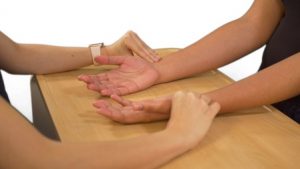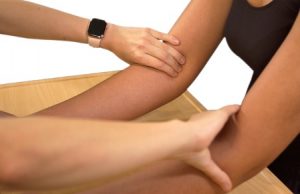Peripheral Vascular System Assessment
Inspection and Palpation of Hands and Arms
Peripheral vascular issues usually affect the lower limbs (feet and legs) more than the upper limbs, but you should begin a complete peripheral vascular assessment with the hands and arms because most clients feel comfortable exposing these areas. However, you might focus on a particular area such as the legs if the assessment is related to a physical trauma and you are concerned about perfusion to that limb. Assessment of the hands and arms can be done while the client is sitting on the side of the exam table or in a high Fowler’s or supine position.
Steps for inspecting and palpating hands and arms include:
- Inspect the skin of the hands and arms for colour (including nails), edema, limb circumference discrepancy, lesions, presence of ulcers, and venous patterns. Ask the client to place their hands and arms in front of them with their palms facing downwards, and then turn their palms upwards. Next, palpate skin temperature using the dorsa of your hands from the shoulders down the arms to the fingertips (see Video 3).
-
- Normally, the skin colour is consistent and skin temperature is warm to touch and equal bilaterally from shoulders to fingertips, although the fingertips can be slightly cool to touch. Normally, there are no signs of cyanosis or pallor in the nails or fingertips. Nails are translucent in colour with a slight pinkish tone underneath. Remember that the palms of hands are a lighter skin colour, particularly among people with darker skin tones. Normally, there is no edema, no ulcers, no lesions and circumference is equal bilaterally.
- Describe the location, size, and quality of any abnormal findings such as skin discolouration, signs of cyanosis, pallor, venous pattern, and presence of ulcers or lesions. With regard to quality, for example, you should note what the discolouration and the ulcers look like. Describe the location and quality of abnormal skin temperatures, particularly if asymmetrical. If you notice any discrepancy in terms of unequal limb circumference, measure with a flexible tape measure at the same location on both limbs to ensure accuracy. Note the location of any edema.
Video 3: Palpation of skin temperature [0:17]
- Test capillary refill on two or three fingernails of each hand at heart level (see Video 4). Start by applying pressure with your own finger to the client’s nail; this causes the nail to blanch (become paler in colour). Apply the pressure for 5 seconds and then release and observe the return in colour.
- A normal finding when assessing capillary refill is colour return that is equal to or less than 3 seconds when assessing capillary refill.
- Colour return that is greater than 3 seconds is described as sluggish return for capillary refill (or slow capillary refill time), and this finding suggests that there may be issues with oxygenated blood perfusion (this may be related to peripheral vascular and/or cardiac and/or respiratory issues). Capillary refill time can be slower if the client’s hands are cold; if the client’s hands are cold from being outside or from washing in cold water, ask them to warm their hands to ensure an accurate reading.
Video 4: Testing capillary refill [0:45]
- Palpate the radial pulses bilaterally and simultaneously, and then palpate the brachial pulses (see Figure 9). Assessing the pulses simultaneously allows you to compare the strength of pulsation; recall the 4-point scale for force. Assessing pulses for the presence, force, and symmetry of force provides information about perfusion (flow of blood) to the limbs. If these pulses are not palpable, you can use a Doppler ultrasound device to assess pulsatile blood flow.
- Normally, pulses are present, 2+ force and equal bilaterally.
- Decreased pulse force or absent pulses can be associated with arterial insufficiency. A decreased pulse force (1+) can be described as “thready,” which refers to a weak pulse that is difficult to feel.


Figure 9: Palpation of radial and brachial pulses.
- Note the findings:
-
- Normal findings might be documented as: “From shoulders to fingertips: equal limb circumference with no edema or ulcers, and skin colour consistent. Good capillary refill. Radial and brachial pulses 2+ force and equal bilaterally. Skin temperature warm to touch and equal bilaterally from shoulders to fingertips.”
- Abnormal findings might be documented as: “Pallor in fingernails, cool to touch in fingers bilaterally, sluggish capillary refill 4–5 seconds, 1+ radial pulses equal bilaterally.”
Activity: Check your Understanding
(Photo by James Heilman, MD, Creative Commons Attribution-Share Alike 3.0 from Wikimedia Commons.)

